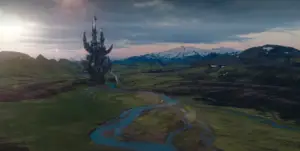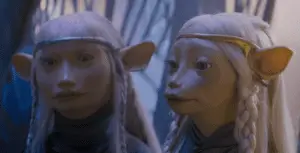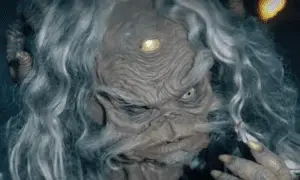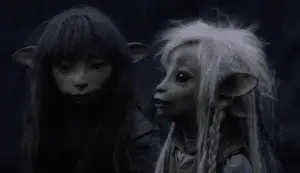It was initially puzzling to me why a TV series associated with the 1982 film The Dark Crystal was coming out 37 years later. Why was Jim Henson’s puppet studio creating The Dark Crystal: Age of Resistance now, after so long? Wasn’t it a little late? After watching the series, though, I think it came out at exactly the right time. The world is finally ready for more Dark Crystal.
When I was growing up, a lot of us nerds were either Dark Crystal kids or Labyrinth kids. Myself, I was a devotee of Labyrinth, a movie that has arguably stood the test of time better than Dark Crystal despite being a box office flop. I’ve seen Labyrinth a dozen times. Its storyline is familiar in a mythological sort of way but novel and fresh. It features a girl protagonist, puppets that seem like living, breathing characters, and great music (David Bowie!). But somehow, even as a fan of Labyrinth and The Muppet Show and everything Jim Henson, I never saw The Dark Crystal as a kid. I think adults around me didn’t respect it, as a film with no fully human, non-puppet actors. It was also seen, rightly, as something too scary for small children.
I finally saw The Dark Crystal for the first time as an adult. The lasting impression it made on me was of a gorgeous, intricately constructed, analog (as opposed to CGI) world – whole landscapes full of critters and various species of flora, made entirely from puppet-stuff. I barely remembered the story after a few years, but I remembered that painstakingly crafted world. So when the new, prequel series was announced, The Dark Crystal: Age of Resistance, I knew I would watch it for the art of the puppetry and the overall visual magic. But I didn’t know if I would be taken by the writing.
High fantasy is a tricky genre. In modern fantasy stories, of which Tolkien is the ur-text, everything that happens is hugely meaningful and important. Someone sets off on a quest against a world-threatening evil power; every encounter is a life-and-death struggle. Characters speak in riddles and study magic until they can stave off mortality itself. Plotlines follow common tropes. Everyone has very serious-sounding names with lots of syllables. There are elves.
All this was deeply, painfully uncool for a long, long time. Tolkien’s works had a little spike of popularity in the 1960s, maybe because the big, love-conquering-evil themes (and stoner Hobbits) appealed to hippies. But when I was growing up, in the 1980s and 90s, everyone had to pretend to be too ironic and cynical for fantasy for a while. Nerds hid their passions. Dungeons & Dragons was still hugely popular, even after the Satanism scares, but it was all secretive; if you were found out as a D&D player, not only would your peers bully you, but your parents might send you to a re-education camp. Satire of fantasy was a popular way for people to connect with this stuff without being ostracized: The Princess Bride is a hit in no small part due to how it strikes a perfect balance between homage to, and ridicule of, the genre.

So, cult classic status notwithstanding, the later 80s, 90s, and early 2000s were probably not a great time for any new entries into the Dark Crystal franchise. In the era of Seinfeld and (peak) South Park, something this Tolkein-y and serious could have tanked. Trekkies could handle other planets filled with alien humanoid creatures, perhaps, but that plus swords and sorcery and puppets would have made Dark Crystal even more niche – especially before the likes of Netflix was around, with a business model involving catering to niche interests.
A few Peter Jacksons, Harry Potters, and Games of Thrones later, fantasy is back, baby. Nerds are running the world – not the right ones, but there they are. There are popular media franchises that follow groups of friends or family members playing D&D together. Few have to hide their interest in fantasy now. This is one of the reasons Dark Crystal has picked a great time to come back.
[Spoilers beyond this point!]
Still, The Dark Crystal: Age of Resistance is different from the Harry Potter or Game of Thrones franchises, in that it’s not trying to be cool. It’s trying to be an authentic re-creation of Jim Henson’s imagined world, albeit with present-day pacing and a dash of modern CGI helping out this time. We’re back to a serious story of good versus evil, small heroes battling huge foes, going on quests to retrieve sacred objects. A princess spends her days reading lore in her library, surrounded by spiral staircases strewn with books, and has a magical vision. A one-eyed witch as old as dirt itself lays in a centuries-long trance, communing with the stars instead of tending to her dying world. Will this stuff fly in 2019?
It flies, friends. It flies like a Crystal Skimmer.
The first episode did begin a little heavy-handed, with a character grieving for a murdered girlfriend we barely got to know, but the show quickly melted away all my chilly 1990s detachment. Unless you are a person who can’t deal with puppets (some can’t – it’s okay), Gelflings will seem like people to you. They have individual and tribal preferences for dress and adornment, and expressive faces, which are notably more believable than the Gelflings in the original movie. Some of them are regal, some are fierce warriors, but they are all small and vulnerable compared to the gigantic Skeksis (who are played by human actors in puppet clothing). And this is part of what draws you in. The show quickly sketches out how the Gelflings are a colonized people, and their oppression is about to become much more brutal than the feudal-style taxation depicted early on. You will feel for the Gelflings. You will want to protect them. All the more if you remember the 1982 movie, to which the 2019 show is a prequel: In the film, it appears that only two surviving Gelflings remain.
The show establishes at least two compelling storylines from the get-go. One involves Deet, a member of the underground-dwelling Grottan clan. Deet is sent on a quest to the above-ground world, where she has never been; at first, she has to wear a cloth tied around her eyes while they adjust to the brightness of the sun. A character who is in tune with nature, Deet approaches this harrowing journey with the joy and wonder of a Gelfling Charles Darwin, making friends with novel species of bugs and worms as she goes. But the above-ground land is dangerous, and the viewer immediately worries for Deet. She has an innocence that makes your heart hurt.
The other storyline that grabs you involves the Al-Maudra, a sort of leader of queens, and her three daughters, all members of the highest-status Vapra clan. Our hero, Brea, the youngest, is the princess library-lurker. She, too, is dragged out of a sheltered life, a quiet existence among her books, but she doesn’t approach this with as much aplomb as Deet.

Brea struggles against her duties imparted to her by her mother and her rule-following, queen-to-be oldest sister, Seladon. The middle sister, Tavra, is a warrior with the laconic, confident personality of someone very physically capable. She mediates between the other two sisters. The interactions between these three were the final piece that sold me on the show. Their relationships simultaneously embody classic tropes from young adult fantasy while being so sisterly and real. The writing and puppetry convey a poignant mix of familial love and resentment between these three characters.
The Dark Crystal: Age of Resistance has a lot of, well, darkness in it. After episode 1, I was marveling at how this story breaks down the idea of colonization in ways children could understand. But after episode 2, I decided would not recommend the show to any child under 12. I think I am not old enough yet for a scene that shockingly closed out the episode, depicting Skeksis punishing one of their own by letting a scorpion-like creature take out his eye.
The seriousness of the show is not unbroken by humor. Andy Sandberg and Bill Hader voice a pair of characters I don’t want to reveal too much about, but their dynamic is charming, and their exposition to the other characters involves puppetry – the creators poking fun at themselves while taking the time to create breathtakingly beautiful meta-puppets. In a later episode, during the tense final face-off between Skeksis and Gelflings, a Fizzgig – a small, round, furry dog-like creature – rolls between the two sides, like a tumbleweed in a Western. These Muppets-esque moments of comic relief make the high-fantasy sincerity of most of the show possible.

The humor, the vulnerability, and humanity of the puppet characters: these things make it possible to embrace the high fantasy and love The Dark Crystal. But there’s more to it than that. The show makes an impact within The Times We Are Living In. Not everybody will feel this way, but a large portion of the kind of audience drawn to this show will feel a certain resonance with current events. A resistance is brewing in the real world. Most of us are momentarily complacent and inactive, like Brea in her library – or even complicit, like the Al-Maudra overseeing the Skeksis’ taxation. But our anger is brewing over the violence of our own Skeksis, and something’s going to overflow.
These times we are living in have seen parts of pop culture embrace radical sincerity. That cool, detached cynicism of the 90s is out. Kindness can truly be a radical act – not niceness (read: civility), which is a closed state, but rather acting out of openness, being genuine, having hope, recognizing others’ humanity. This trend is showing itself in media in all sorts of ways. It is because of this trend in our culture, I think, that certain scenes in Dark Crystal filled with high emotion can work properly, can really have impact.
One such scene involves the giant spider-like creatures called Arathim. The Skeksi emperor has convinced the Arathim to side with them against the Gelfling rebellion, in exchange for returning to the Arathim their ancestral home that the Skeksis once expelled them from. This home turns out to be the caves of Grot – the current home of Deet and her family. The Arathim keep up their end of the deal. But when they return to reclaim the caves and drive out the Grottan clan, they find that the cave worms, huge Dune-inspired beasts, have been infected with the Darkening (the world-threatening sickness the Skeksis have set in motion), and are eating the Arathim. The Skeksis have sent them there to die.
In the chaos, Deet manages to open a line of communication to the Arathim; she learns for the first time that the Arathim lived in the caves before Gelflings, and the Skeksis drove them from their home. Deet only takes a moment to assimilate this historical injustice. She explains that her people, the Grottan, are named after this place, but if the Arathim lived in the caves before them, then they are Grottan, too. With that simple statement – in effect, we are all Grottan – Deet repairs an ancient rift between two peoples, and unites them against their common enemy. Together, they lead everyone they can out to the aboveground and safety.

This moment could have been – should have been! – kind of cheesy, but I found it incredibly moving. As I watched, some more detached, adult part of my brain knew that, in real life, long, historical conflicts cannot be so easily solved. But the heart part of my brain longs for this, needs this fantasy. And so I deeply believed in Deet in this world, and her power to cure such wrongs.
That’s when I realized that 2019 is the perfect time for The Dark Crystal: Age of Resistance. Fantasy has become cool as a genre; oppression and revolt are on our minds; and a new era of sincerity without naiveté has come to pop culture, the internet, and real life. Maybe we are finally ready for this show now. May the resistance thrive.

